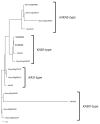Molecular characterization of two high-palmitic-acid mutant loci induced by X-ray irradiation in soybean
- PMID: 23136502
- PMCID: PMC3406799
- DOI: 10.1270/jsbbs.61.631
Molecular characterization of two high-palmitic-acid mutant loci induced by X-ray irradiation in soybean
Abstract
Palmitic acid is the most abundant (approx. 11% of total fatty acids) saturated fatty acid in conventional soybean seed oil. Increasing the saturated acid content of soybean oil improves its oxidative stability and plasticity. We have developed three soybean mutants with high palmitic acid content by X-ray irradiation. In this study, we successfully identified the mutated sites of two of these high-palmitic-acid mutants, J10 and M22. PCR-based mutant analysis revealed that J10 has a 206,203-bp-long deletion that includes the GmKASIIA gene and 16 other predicted genes, and M22 has a 26-bp-long deletion in the sixth intron of GmKASIIB. The small deletion in M22 causes mis-splicing of GmKASIIB transcripts, which should result in nonfunctional products. In addition, we designed co-dominant marker sets for these mutant alleles and confirmed the association of genotypes and palmitic acid contents in F(2) seeds of J10 X M22. This information will be useful in breeding programs to develop novel soybean cultivars with improved palmitic acid content. However, in the third mutant, KK7, we found no polymorphism in either GmKASIIA or GmKASIIB, which suggests that several unknown genes in addition to GmKASIIA and GmKASIIB may be involved in elevating the palmitic acid content of soybean seed oil.
Keywords: Glycine max; GmKASIIA; GmKASIIB; X-ray irradiation; palmitic acid.
Figures






Similar articles
-
Genome-wide identification and analysis of soybean acyl-ACP thioesterase gene family reveals the role of GmFAT to improve fatty acid composition in soybean seed.Theor Appl Genet. 2021 Nov;134(11):3611-3623. doi: 10.1007/s00122-021-03917-9. Epub 2021 Jul 28. Theor Appl Genet. 2021. PMID: 34319424
-
QTL Mapping of Palmitic Acid Content Using Specific-Locus Amplified Fragment Sequencing (SLAF-Seq) Genotyping in Soybeans (Glycine max L.).Int J Mol Sci. 2022 Sep 24;23(19):11273. doi: 10.3390/ijms231911273. Int J Mol Sci. 2022. PMID: 36232577 Free PMC article.
-
Inheritance and Interaction of Low Palmitic and Low Linolenic Soybean.Crop Sci. 2002 Jan;42(1):31-36. doi: 10.2135/cropsci2002.3100. Crop Sci. 2002. PMID: 11756250
-
GmWRI1c Increases Palmitic Acid Content to Regulate Seed Oil Content and Nodulation in Soybean (Glycine max).Int J Mol Sci. 2022 Nov 9;23(22):13793. doi: 10.3390/ijms232213793. Int J Mol Sci. 2022. PMID: 36430287 Free PMC article.
-
Genetic possibilities for altering sunflower oil quality to obtain novel oils.Can J Physiol Pharmacol. 2008 Apr;86(4):215-21. doi: 10.1139/Y08-008. Can J Physiol Pharmacol. 2008. PMID: 18418432 Review.
Cited by
-
Development and utilization of a new chemically-induced soybean library with a high mutation density .J Integr Plant Biol. 2017 Jan;59(1):60-74. doi: 10.1111/jipb.12505. J Integr Plant Biol. 2017. PMID: 27774740 Free PMC article.
-
Potential of a mutant-based reverse genetic approach for functional genomics and molecular breeding in soybean.Breed Sci. 2012 Jan;61(5):462-7. doi: 10.1270/jsbbs.61.462. Epub 2012 Feb 4. Breed Sci. 2012. PMID: 23136486 Free PMC article.
-
Genetic enhancement of palmitic acid accumulation in cotton seed oil through RNAi down-regulation of ghKAS2 encoding β-ketoacyl-ACP synthase II (KASII).Plant Biotechnol J. 2017 Jan;15(1):132-143. doi: 10.1111/pbi.12598. Epub 2016 Sep 7. Plant Biotechnol J. 2017. PMID: 27381745 Free PMC article.
-
Structural and functional characterization of a novel GmKASII-A allele associated with saturated fatty acid composition in EMS-induced mutant PE1544.BMC Plant Biol. 2025 Jul 2;25(1):818. doi: 10.1186/s12870-025-06836-9. BMC Plant Biol. 2025. PMID: 40604469 Free PMC article.
-
Single-base deletion in GmCHR5 increases the genistein-to-daidzein ratio in soybean seed.Breed Sci. 2020 Jun;70(3):265-276. doi: 10.1270/jsbbs.19134. Epub 2020 May 19. Breed Sci. 2020. PMID: 32714048 Free PMC article.
References
-
- Aghoram K, Wilson RF, Burton JW, Dewey RE. A mutation in a 3-keto-acyl-ACP synthase gene is associated with elevated palmitic acid levels in soybean seeds. Crop Sci. 2006;46:2453–2459.
-
- Anai T, Yamada T, Kinoshita T, Rahman SM, Takagi Y. Identification of corresponding genes for three low-α-linolenic acid mutants and elucidation of their contribution to fatty acid biosynthesis in soybean seed. Plant Sci. 2005;168:1615–1623.
-
- Anai T, Yamada T, Hideshima R, Kinoshita T, Rahman SM, Takagi Y. Two high-oleic-acid soybean mutants, M23 and KK21, have disrupted microsomal omega-6 fatty acid desaturase, encoded by GmFAD2-1a. Breed Sci. 2008;58:447–452.
-
- Carlsson AS, LaBrie ST, Kinney AJ, von Wettstein-Knowles P, Browse J. A KAS2 cDNA complements the phenotypes of the Arabidopsis fab1 mutant that differs in a single residue bordering the substrate binding pocket. Plant J. 2002;29:761–770. - PubMed
-
- Erickson EA, Wilcox JR, Cavins JF. Inheritance of altered palmitic acid percentages in two soybean mutants. J Hered. 1988;79:465–468.
LinkOut - more resources
Full Text Sources
Research Materials
Miscellaneous
